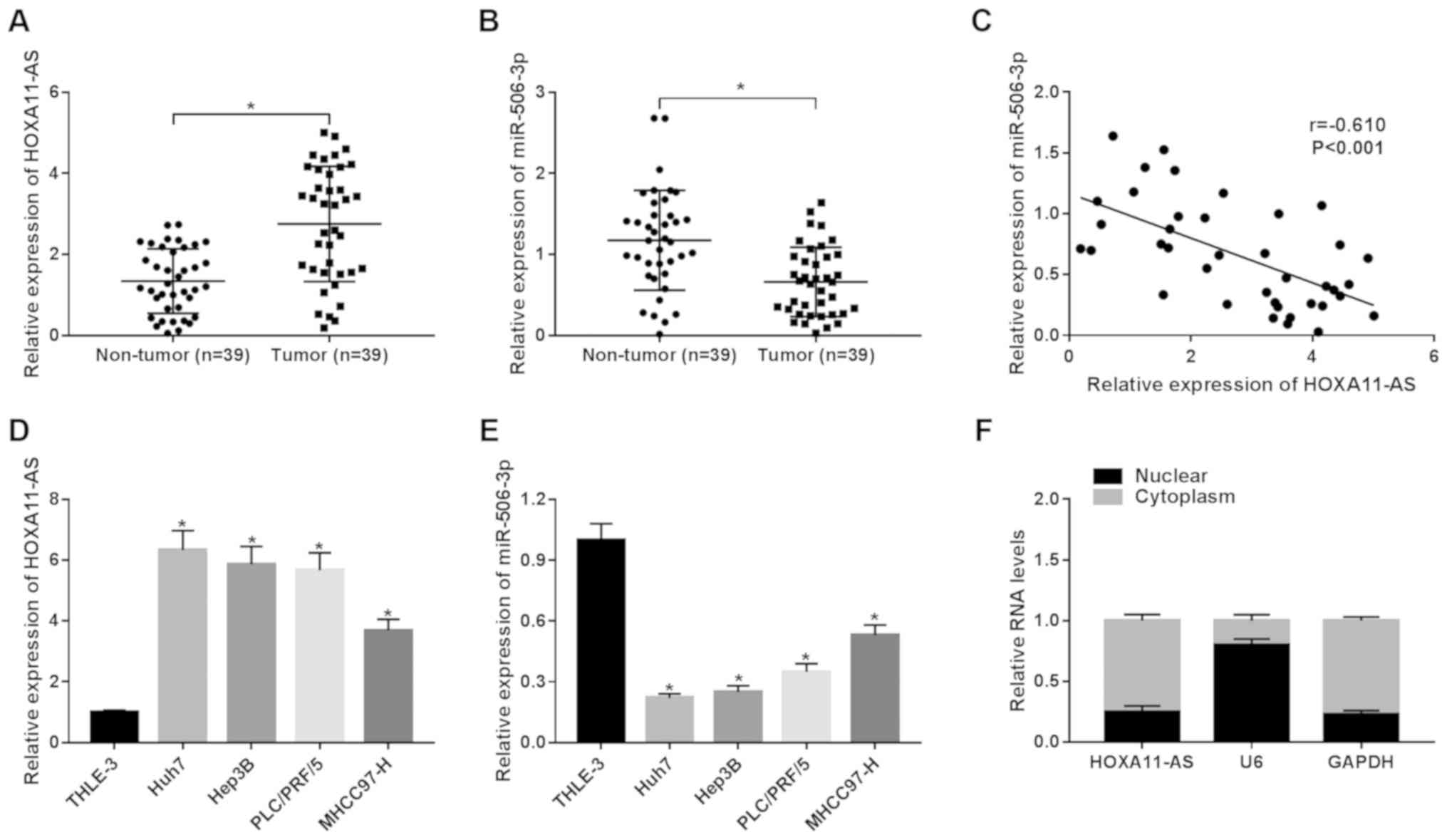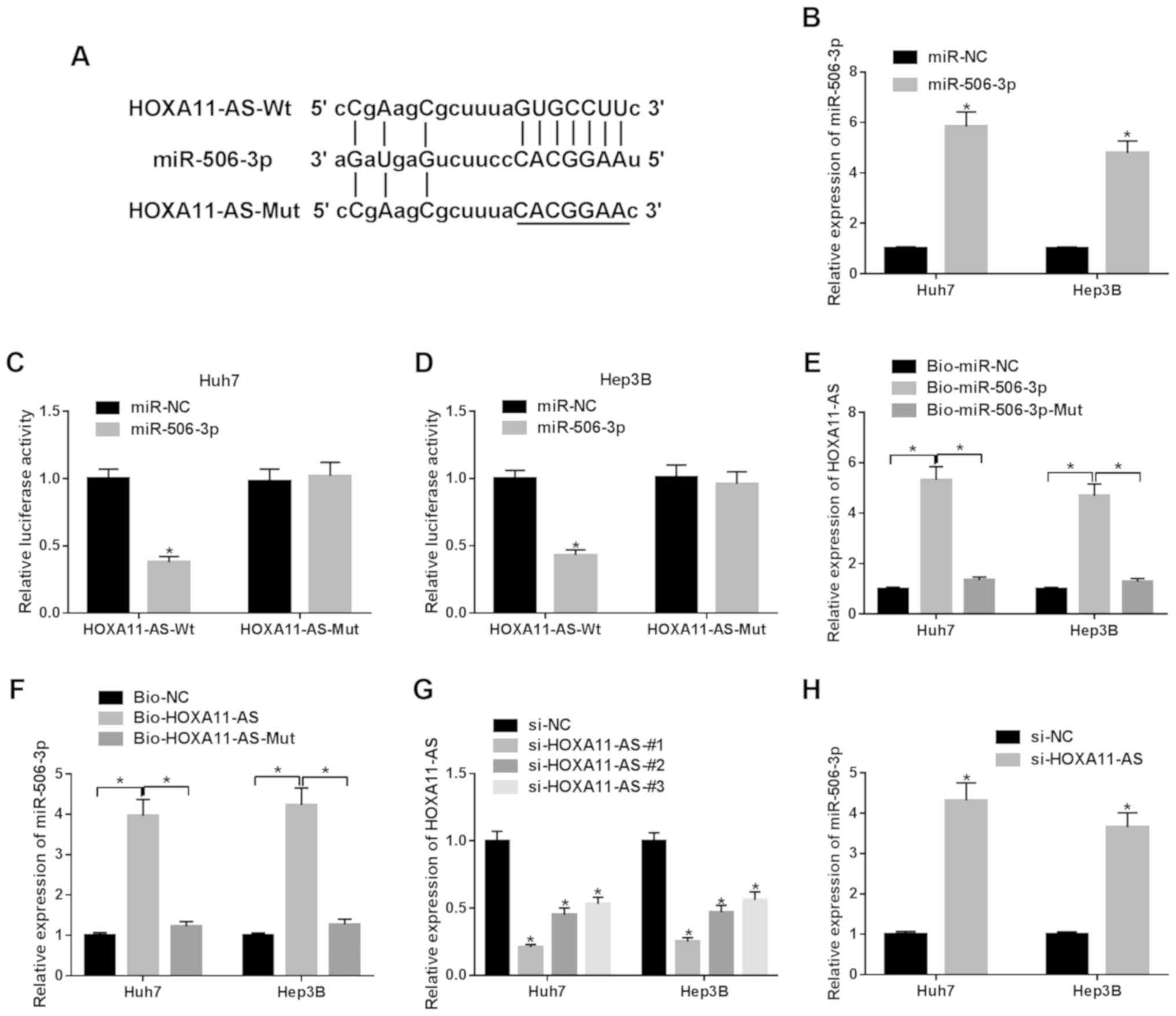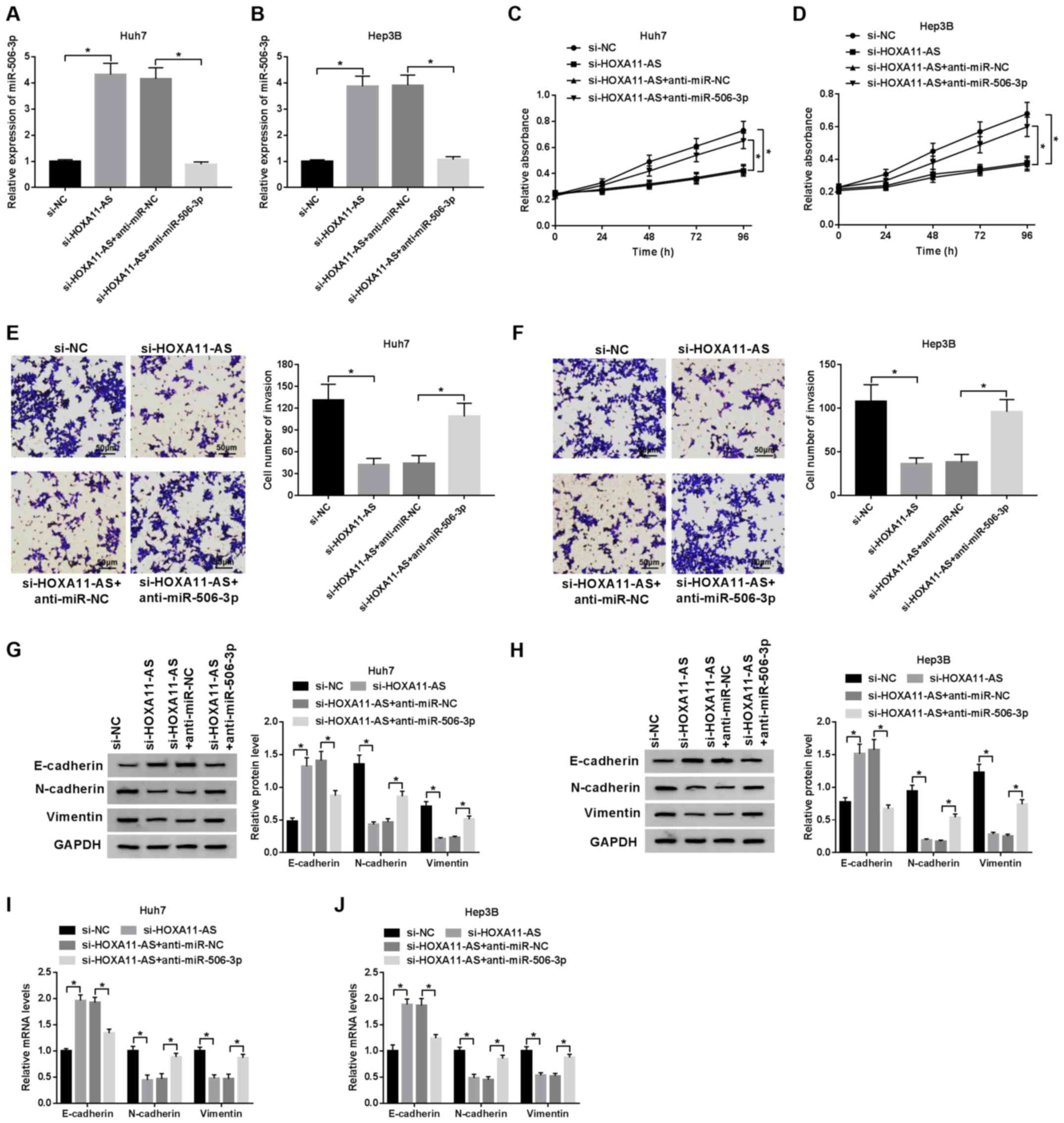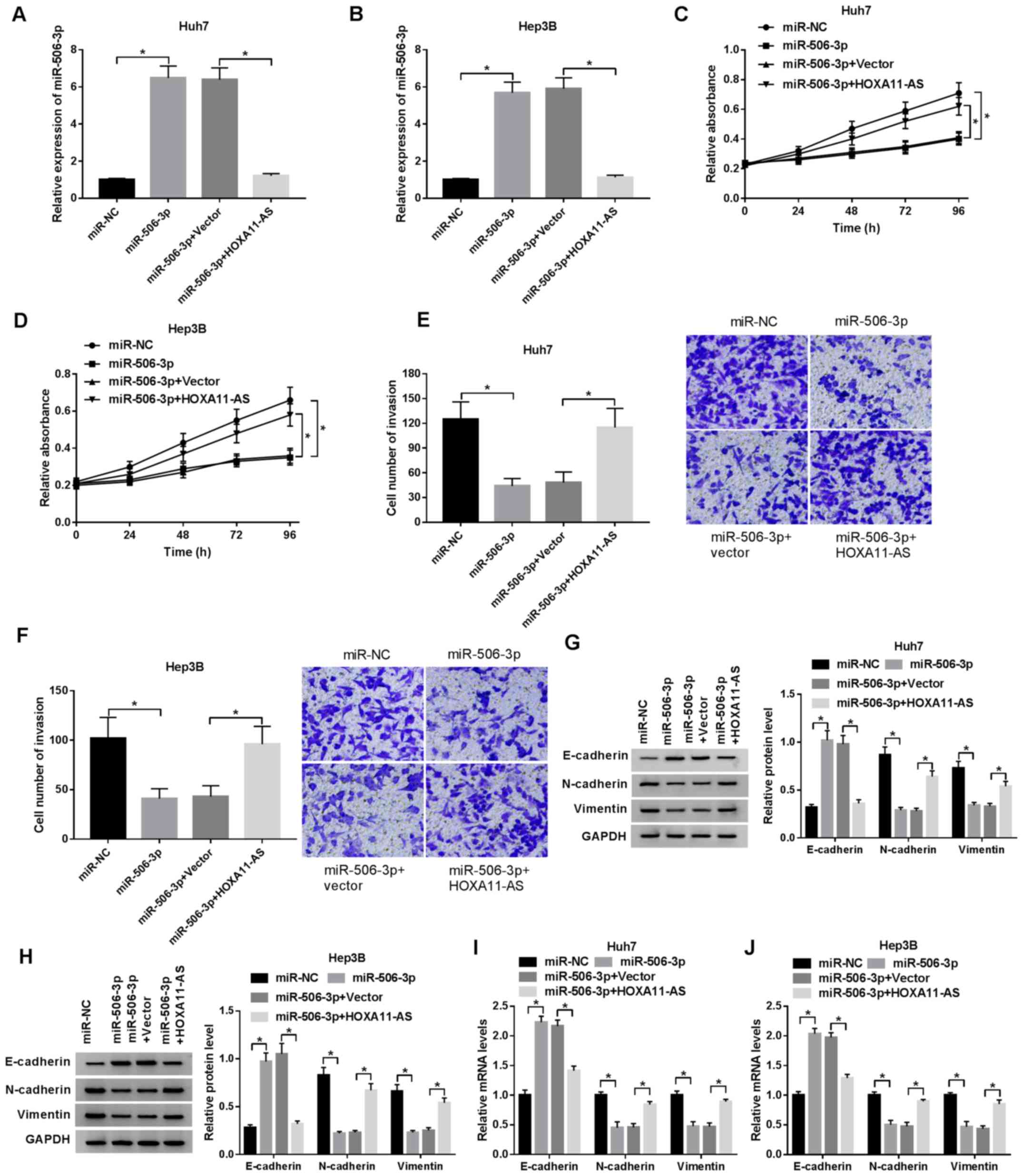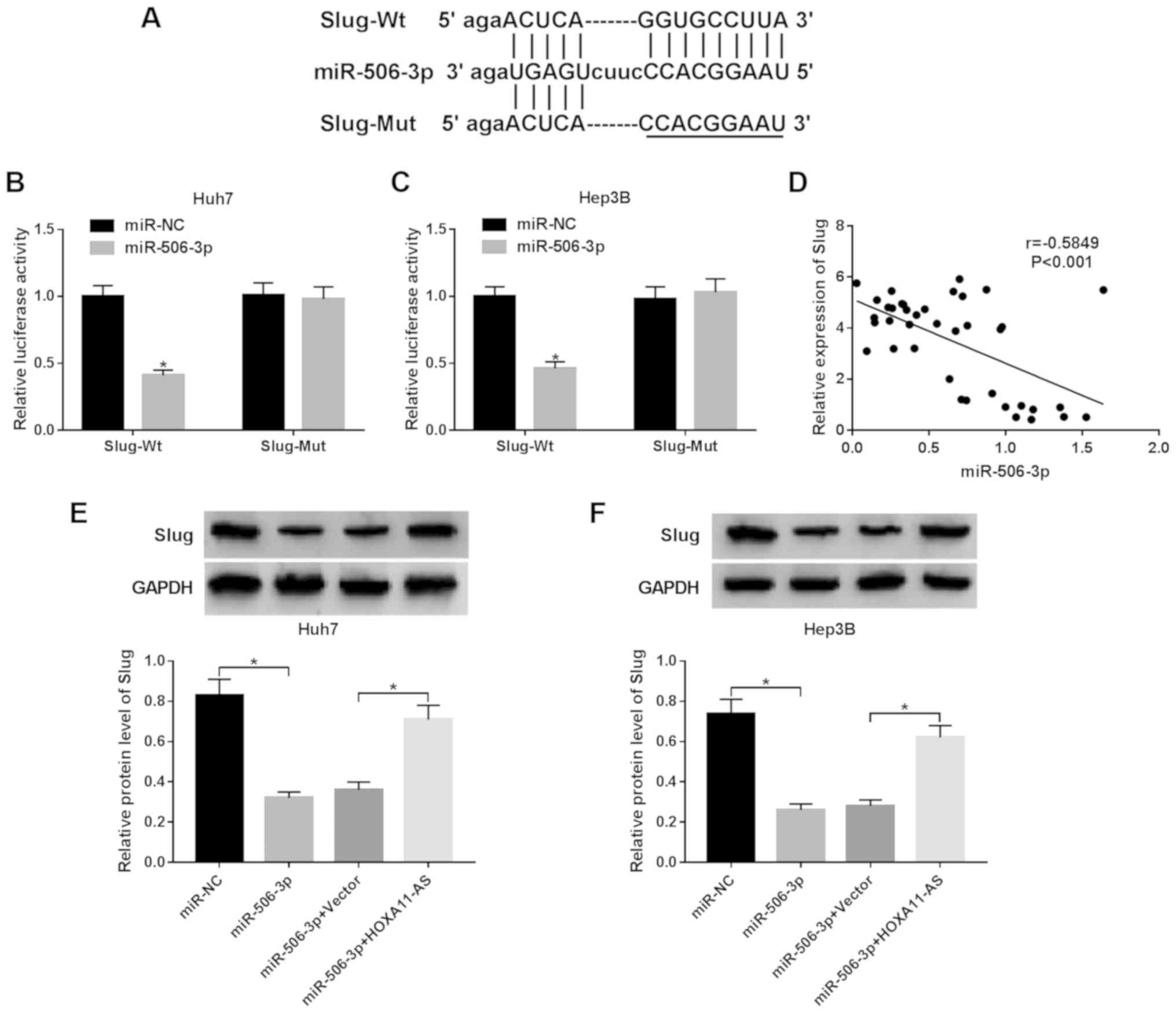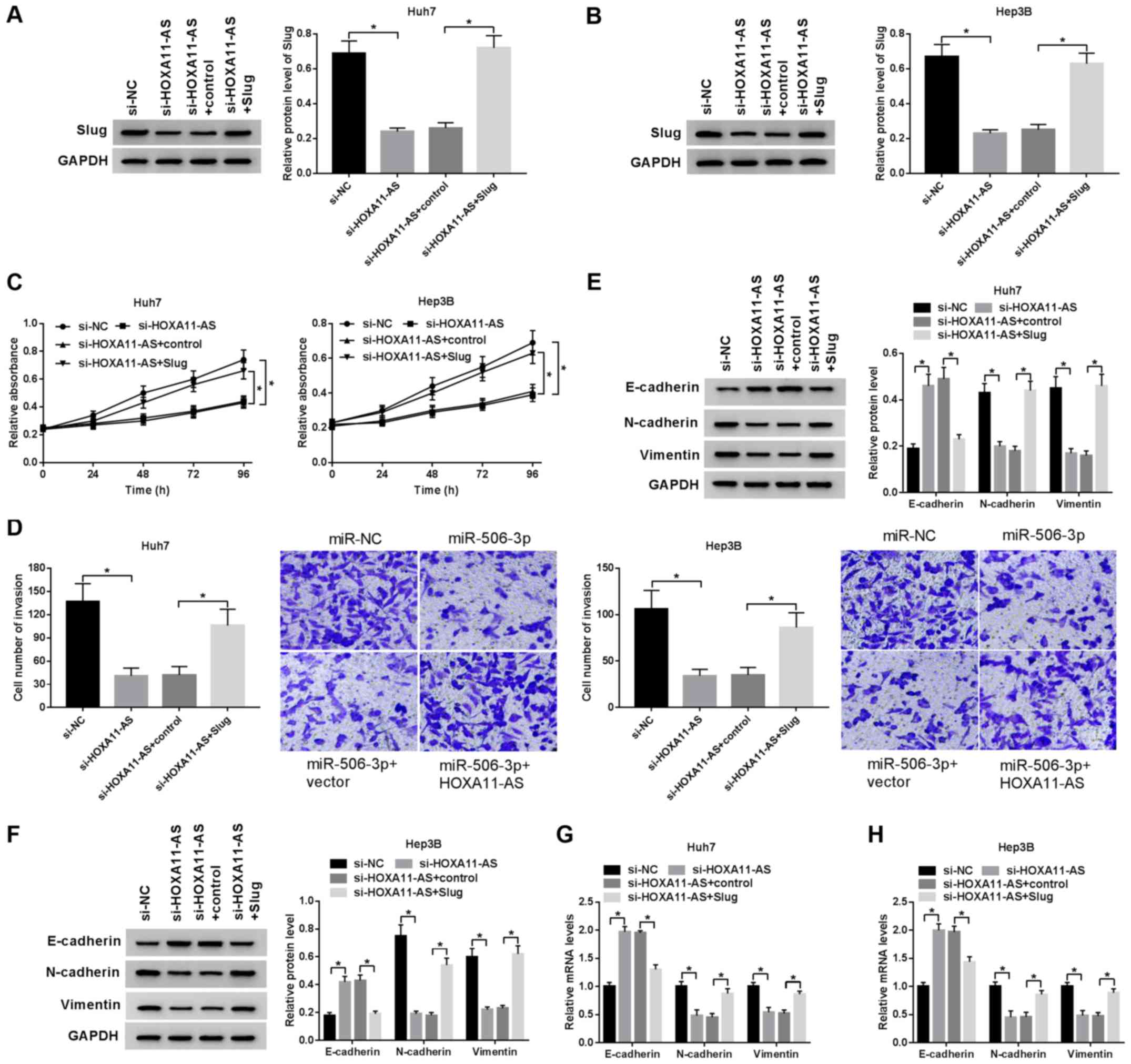|
1
|
Soliman B, Salem A, Ghazy M, Abu-Shahba N
and El Hefnawi M: Bioinformatics functional analysis of let-7a,
miR-34a, and miR-199a/b reveals novel insights into immune system
pathways and cancer hallmarks for hepatocellular carcinoma. Tumour
Biol. 40:10104283187736752018. View Article : Google Scholar : PubMed/NCBI
|
|
2
|
Liu X, Wang S, Xu J, Kou B, Chen D, Wang Y
and Zhu X: Extract of Stellerachamaejasme L(ESC) inhibits growth
and metastasis of human hepatocellular carcinoma via regulating
microRNA expression. BMC Complement Altern Med. 18:992018.
View Article : Google Scholar : PubMed/NCBI
|
|
3
|
Hughes A and Dhoot GK: Dysregulated cancer
cell transdifferentiation into erythrocytes is an additional
metabolic stress in hepatocellular carcinoma. Tumour Biol.
40:10104283188114672018. View Article : Google Scholar : PubMed/NCBI
|
|
4
|
Wang J, Sun J, Zhang N, Yang R, Li H,
Zhang Y, Chen K and Kong D: PES1 enhances proliferation and
tumorigenesis in hepatocellular carcinoma via the PI3K/AKT pathway.
Life Sci. 219:182–189. 2019. View Article : Google Scholar : PubMed/NCBI
|
|
5
|
Huang S, Zhu P, Sun B, Guo J, Zhou H, Shu
Y and Li Q: Modulation of YrdC promotes hepatocellular carcinoma
progression via MEK/ERK signaling pathway. Biomed Pharmacother.
114:1088592019. View Article : Google Scholar : PubMed/NCBI
|
|
6
|
Sheng N and Li Y, Qian R and Li Y: The
clinical significance and biological function of lncRNA RGMB-AS1 in
hepatocellular carcinoma. Biomed Pharmacother. 98:577–584. 2018.
View Article : Google Scholar
|
|
7
|
XU CH, Xiao LM, Liu Y, Chen LK, Zheng SY,
Zeng EM and Li DH: The lncRNA HOXA11-AS promotes glioma cell growth
and metastasis by targeting miR-130a-5p/HMGB2. Eur Rev Med
Pharmacol Sci. 2:241–252. 2019.
|
|
8
|
Jin QS, Huang LJ, Zhao TT, Yao XY, Lin LY,
Teng YQ, Kim SH, Nam MS, Zhang LY and Jin YJ: HOXA11-AS regulates
diabetic arteriosclerosis-related inflammation via PI3K/AKT
pathway. Eur Rev Med Pharmacol Sci. 22:6912–6921. 2018.PubMed/NCBI
|
|
9
|
Xu C, He T, Li Z, Liu H and Ding B:
Regulation of HOXA11-AS/miR-214-3p/EZH2 axis on the growth,
migration and invasion of glioma cells. Biomed Pharmacother.
95:1504–1513. 2017. View Article : Google Scholar : PubMed/NCBI
|
|
10
|
Lu CW, Zhou DD, Xie T, Hao JL, Pant OP, Lu
CB and Liu XF: HOXA11 antisense long noncoding RNA (HOXA11-AS): A
promising lncRNA in human cancers. Cancer Med. 7:3792–3799. 2018.
View Article : Google Scholar : PubMed/NCBI
|
|
11
|
Qu L, Jin M, Yang L, Sun C, Wang P, Li Y,
Tian L, Liu M and Sun Y: Expression of long non-coding RNA
HOXA11-AS is correlated with progression of laryngeal squamous cell
carcinoma. Am J Transl Res. 10:573–580. 2018.PubMed/NCBI
|
|
12
|
Yang FQ, Zhang JQ, Jin JJ, Yang CY, Zhang
WJ, Zhang HM, Zheng JH and Weng ZM: HOXA11-AS promotes the growth
and invasion of renal cancer by sponging miR-146b-5p to upregulate
MMP16 expression. J Cell Physiol. 233:9611–9619. 2018. View Article : Google Scholar : PubMed/NCBI
|
|
13
|
Zhao X, Li X, Zhou L, Ni J, Yan W, Ma R,
Wu J, Feng J and Chen P: LncRNA HOXA11-AS drives cisplatin
resistance of human LUAD cells via modulating miR-454-3p/Stat3.
Cancer Sci. 109:3068–3079. 2018. View Article : Google Scholar : PubMed/NCBI
|
|
14
|
Liang TS, Zheng YJ, Wang J, Zhao JY, Yang
DK and Liu ZS: MicroRNA-506 inhibits tumor growth and metastasis in
nasopharyngeal carcinoma through the inactivation of the
Wnt/β-catenin signaling pathway by down-regulating LHX2. J Exp Clin
Cancer Res. 38:972019. View Article : Google Scholar
|
|
15
|
He H, Liao X, Yang Q, Liu Y, Peng Y, Zhong
H, Yang J, Zhang H, Yu Z, Zuo Y, et al: MicroRNA-494-3p promotes
cell growth, migration, and invasion of nasopharyngeal carcinoma by
targeting sox7. Technol Cancer Res Treat. 17:15330338188099932018.
View Article : Google Scholar : PubMed/NCBI
|
|
16
|
Lin C, Zong J, Lin W, Wang M, Xu Y, Zhou
R, Lin S, Guo Q, Chen H, Ye Y, et al: EBV-miR-BART8-3p induces
epithelial-mesenchymal transition and promotes metastasis of
nasopharyngeal carcinoma cells through activating NF-κB and Erk1/2
pathways. J Exp Clin Cancer Res. 37:2832018. View Article : Google Scholar
|
|
17
|
Yi F, Hao Y, Chong X and Zhong W:
Overexpression of microRNA-506-3p aggravates the injury of vascular
endothelial cells in patients with hypertension by downregulating
Beclin1 expression. Exp Ther Med. 15:2844–2850. 2018.PubMed/NCBI
|
|
18
|
Wang LK, Xie XN, Song XH, Su T, Chang XL,
Xu M, Liang B and Huang DY: Upregulation of miR-200b inhibits
hepatocellular carcinoma cell proliferation and migration by
targeting HMGB3 protein. Technol Cancer Res Treat.
17:15330338188064752018. View Article : Google Scholar : PubMed/NCBI
|
|
19
|
Livak KJ and Schmittgen TD: Analysis of
relative gene expression data using real-time quantitative PCR and
the 2(-Delta Delta C(T)) method. Methods. 25:402–408. 2001.
View Article : Google Scholar
|
|
20
|
Hu H, Yang L, Li L and Zeng C: Long
non-coding RNA KCNQ1OT1 modulates oxaliplatin resistance in
hepatocellular carcinoma through miR-7-5p/ABCC1 axis. Biochem
Biophys Res Commun. 503:2400–2406. 2018. View Article : Google Scholar : PubMed/NCBI
|
|
21
|
Lu S, Jiang X, Su Z, Cui Z, Fu W and Tai
S: The role of the long non-coding RNA HOXA11-AS in promoting
proliferation and metastasis of malignant tumors. Cell Biol Int.
42:1596–1601. 2018. View Article : Google Scholar : PubMed/NCBI
|
|
22
|
Misawa A, Takayama K, Urano T and Inoue S:
Androgen-induced long noncoding RNA (lncRNA) SOCS2-AS1 promotes
cell growth and inhibits apoptosis in prostate cancer cells. J Biol
Chem. 291:17861–17880. 2016. View Article : Google Scholar : PubMed/NCBI
|
|
23
|
Wang YL, Liu JY, Yang JE, Yu XM, Chen ZL,
Chen YJ, Kuang M, Zhu Y and Zhuang SM: Lnc-UCID promotes G1/S
transition and hepatoma growth by preventing DHX9-mediated CDK6
down-regulation. Hepatology. 70:259–275. 2019.PubMed/NCBI
|
|
24
|
Huang D, Wei Y, Zhu J and Wang F: Long
non-coding RNA SNHG1 functions as a competitive endogenous RNA to
regulate PDCD4 expression by sponging miR-195-5p in hepatocellular
carcinoma. Gene. 714:1439942019. View Article : Google Scholar : PubMed/NCBI
|
|
25
|
Zhang Q, Chen Y and Liu K: Erratum:
miR-185 inhibits cell migration and invasion of hepatocellular
carcinoma through CDC42. Oncol Lett. 19:10892020.PubMed/NCBI
|
|
26
|
Hu QL, Xu ZP, Lan YF and Li B: miR-636
represses cell survival by targeting CDK6/Bcl-2 in cervical cancer.
Kaohsiung J Med Sci. 36:328–335. 2020. View Article : Google Scholar : PubMed/NCBI
|
|
27
|
Jia P, Wei G, Zhou C, Gao Q, Wu Y, Sun X
and Li X: Upregulation of MiR-212 inhibits migration and
tumorigenicity and inactivates Wnt/β-catenin signaling in human
hepatocellular carcinoma. Technol Cancer Res Treat.
17:15330346187652212018. View Article : Google Scholar
|
|
28
|
Wang J, Lu L, Luo Z, Li W, Lu Y, Tang Q
and Pu J: miR-383 inhibits cell growth and promotes cell apoptosis
in hepatocellular carcinoma by targeting IL-17 via STAT3 signaling
pathway. Biomed Pharmacother. 120:1095512019. View Article : Google Scholar : PubMed/NCBI
|
|
29
|
Cui Y, Yi L, Zhao JZ and Jiang YG: Long
noncoding RNA HOXA11-AS functions as miRNA sponge to promote the
glioma tumorigenesis through targeting miR-140-5p. DNA Cell Biol.
36:822–828. 2017. View Article : Google Scholar : PubMed/NCBI
|
|
30
|
Yu W, Peng W, Jiang H, Sha H and Li J:
LncRNA HOXA11-AS promotes proliferation and invasion by targeting
miR-124 in human non-small cell lung cancer cells. . Tumour Biol.
39:10104283177214402017. View Article : Google Scholar
|
|
31
|
Yin X, Zhang J, Li C, Zhang Z, Jin T, Song
L, Zhang R, Wang W, Tao Y and Wang X: LncRNA HOXA11-AS
accumulation-induced microRNA-761 downregulation regulates cell
growth by targeting TRIM29 in papillary thyroid cancer. Am J Transl
Res. 11:6826–6837. 2019.PubMed/NCBI
|
|
32
|
Niu X, Yang B, Liu F and Fang Q: LncRNA
HOXA11-AS promotes OSCC progression by sponging miR-98-5p to
upregulate YBX2 expression. Biomed Pharmacother. 121:1096232020.
View Article : Google Scholar
|
|
33
|
Chen D, Sun Q, Zhang L, Zhou X, Cheng X,
Zhou D, Ye F, Lin J and Wang W: The lncRNA HOXA11-AS functions as a
competing endogenous RNA to regulate PADI2 expression by sponging
miR-125a-5p in liver metastasis of colorectal cancer. Oncotarget.
8:70642–70652. 2017. View Article : Google Scholar : PubMed/NCBI
|
|
34
|
Zhan M, He K, Xiao J, Liu F, Wang H, Xia
Z, Duan X, Huang R, Li Y, He X, et al: LncRNA HOXA11-AS promotes
hepatocellular carcinoma progression by repressing miR-214-3p. J
Cell Mol Med. 22:3758–3767. 2018. View Article : Google Scholar :
|
|
35
|
Wang Y, Lei X, Gao C, Xue Y, Li X, Wang H
and Feng Y: MiR-506-3p suppresses the proliferation of ovarian
cancer cells by negatively regulating the expression of MTMR6. J
Biosci. 44:1262019. View Article : Google Scholar
|
|
36
|
Wu L, Chen Z and Xing Y: MiR-506-3p
inhibits cell proliferation, induces cell cycle arrest and
apoptosis in retinoblastoma by directly targeting NEK6. Cell Biol
Int. Aug 6–2018.Epub ahead of print. View Article : Google Scholar
|
|
37
|
Hu CY, You P, Zhang J, Zhang H and Jiang
N: MiR-506-3p acts as a novel tumor suppressor in prostate cancer
through targeting GALNT4. Eur Rev Med Pharmacol Sci. 23:5133–5138.
2019.PubMed/NCBI
|
|
38
|
Huang B, Liu C, Wu Q, Zhang J, Min Q,
Sheng T, Wang X and Zou Y: Long non-coding RNA NEAT1 facilitates
pancreatic cancer progression through negative modulation of
miR-506-3p. Biochem Biophys Res Commun. 482:828–834. 2017.
View Article : Google Scholar
|
|
39
|
Guo S, Yang P, Jiang X, Li X, Wang Y,
Zhang X, Sun B, Zhang Y and Jia Y: Genetic and epigenetic silencing
of mircoRNA-506-3p enhances COTL1 oncogene expression to foster
non-small lung cancer progression. Oncotarget. 8:644–657. 2017.
View Article : Google Scholar :
|
|
40
|
Mani SA, Guo W, Liao MJ, Eaton EN, Ayyanan
A, Zhou AY, Brooks M, Reinhard F, Zhang CC, Shipitsin M, et al: The
epithelial-mesenchymal transition generates cells with properties
of stem cells. Cell. 133:704–715. 2008. View Article : Google Scholar : PubMed/NCBI
|
|
41
|
Jiang H, Li T, Qu Y, Wang X, Li B, Song J,
Sun X, Tang Y, Wan J, Yu Y, et al: Long non-coding RNA SNHG15
interacts with and stabilizes transcription factor Slug and
promotes colon cancer progression. Cancer Lett. 425:78–87. 2018.
View Article : Google Scholar : PubMed/NCBI
|
|
42
|
Cui RJ, Fan JL, Lin YC, Pan YJ, Liu C, Wan
JH, Wang W, Jiang ZY, Zheng XL, Tang JB and Yu XG: miR-124-3p
availability is antagonized by LncRNA-MALAT1 for Slug-induced tumor
metastasis in hepatocellular carcinoma. Cancer Med. 8:6358–6369.
2019. View Article : Google Scholar : PubMed/NCBI
|















